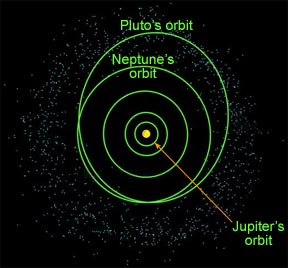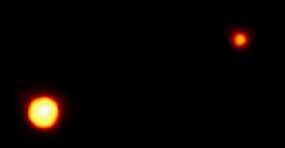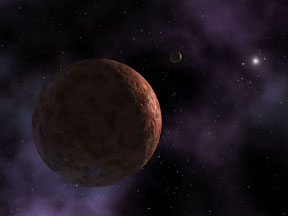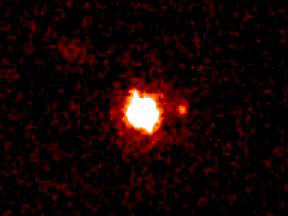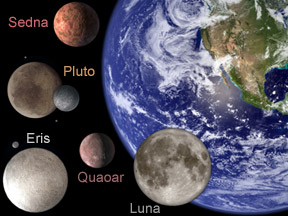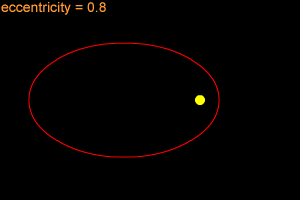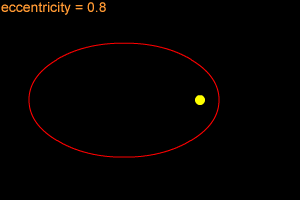Click on image for full size
Image courtesy NASA/JPL-Caltech.
The Kuiper Belt
Thousands of frozen worlds hover at the edge of our Solar System. These frigid balls of ice and rock, similar in location and size to the planet Pluto, orbit the Sun in a distant region called the Kuiper Belt.Frederick Leonard (1930) and Kenneth Edgeworth (1943) postulated the existence of the Kuiper Belt in the first half of the 20th century. Gerard Kuiper, in whose honor the region is named, suggested in 1951 that the Kuiper Belt might be the source of short-period comets. Astronomers David Jewitt and Jane Luu discovered the first actual Kuiper Belt Object (KBO), dubbed (15760) 1992 QB1, in 1992. KBOs are difficult to detect because their extreme distance makes them appear quite small and dim, and because they move so slowly along their orbits.
Hundreds of KBOs have been found since 1992. They orbit out beyond Neptune, in the general neighborhood of Pluto. Most are located between about 30 and 50 AU from the Sun, though some astronomers claim the belt extends out to around 100 AU. They typically take a couple of centuries to complete each orbit around the Sun. KBOs are large balls of ice and rock, similar in composition to Pluto and its largest moon Charon. In fact, the planet Pluto is also considered to be a member of the Kuiper Belt.
Kuiper Belt Objects are just part of larger group of Trans-Neptunian Objects (TNOs) that orbit further from the Sun than Neptune. TNOs in another region called the Oort Cloud orbit much, much further from the Sun than the Kuiper Belt. Some scientists also recognize a class of "scattered disc objects" (SDOs) with orbits intermediate between those of the Kuiper Belt and of the Oort Cloud. KBOs generally orbit near the ecliptic plane in which the planets move. SDOs can have orbits whose planes are more tilted. The orbits of Oort Cloud objects can have arbitrary tilts, so the objects are scattered in a spherical distribution around the Sun, unlike the "doughnut shaped" distribution of KBOs.
Astronomers estimate that there may be more than 100,000 KBOs with a diameter greater than 100 km (62 miles), and perhaps a billion larger than 10 km (6 miles) across. There might be 10 or 20 KBOs larger than Pluto awaiting discovery. One scattered disc object, dubbed 2003 UB313 (and nicknamed "Xena"), apparently is larger than Pluto and has been called the "tenth planet" by some scientists. The discovery of Xena and of KBOs almost as big as Pluto has added fuel to the debate about an official definition of the term "planet".
There are a couple of classes of KBOs. Some have orbits that take them around the Sun twice for every three times Neptune orbits. Objects in such orbital resonances, which are especially prone to influence by Neptune's gravity, are called "plutinos" because the planet Pluto is amongst them. Some KBOs have more circular orbits than Pluto and are not influenced by Neptune; they are called "cubewanos" (QB1-o's) after the first KBO ever found, 1992 QB1, which is one of them.
Kuiper Belt Objects may provide us with clues about the history and evolution of our Solar System. Some may include nearly pristine material that has been in a deep freeze since the earliest years of our Solar System's history. The orbits of KBOs may help us understand whether and how the orbits of the gas and ice giant planets may have evolved over our planetary system's lifetime.
Neptune's large moon Triton may be a KBO that was captured by the giant planet. Several KBOs have been seen to have small moons of their own. Some of the better-known KBOs include Pluto (and its moon Charon), 1992 QB1, Orcus, Quaoar, Ixion, and Varuna.


